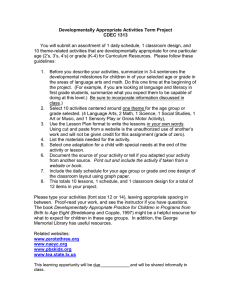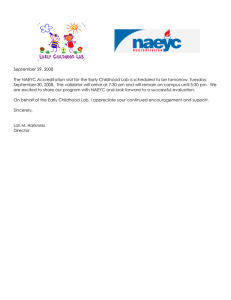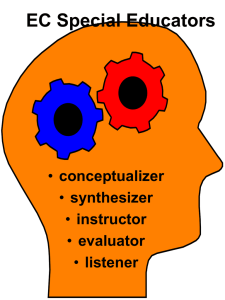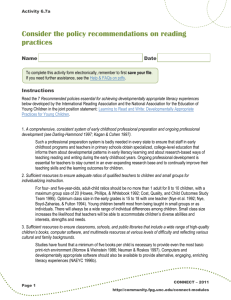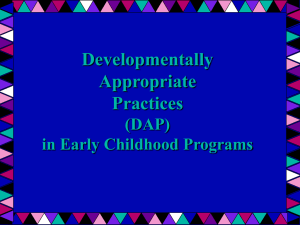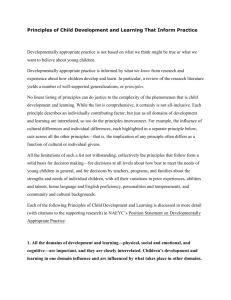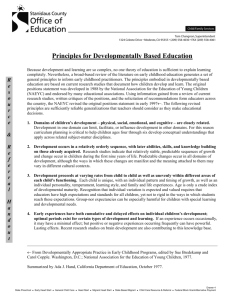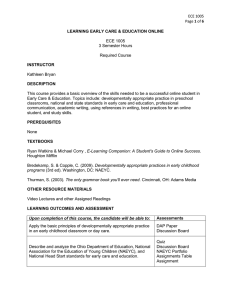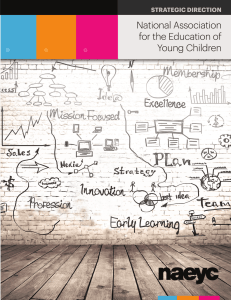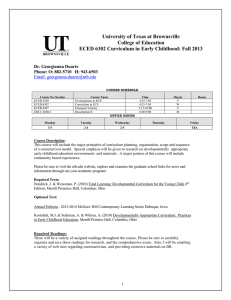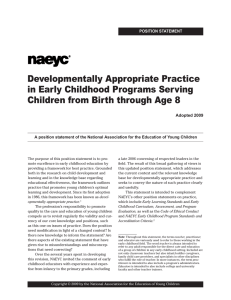Document 13030824
advertisement
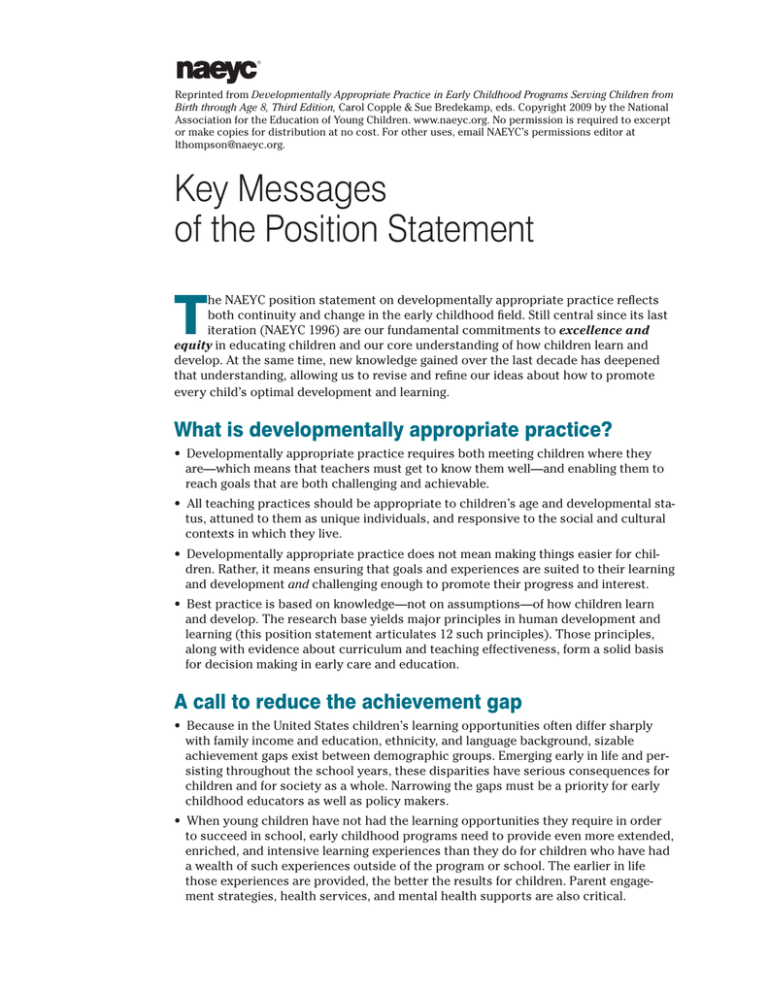
Reprinted from Developmentally Appropriate Practice in Early Childhood Programs Serving Children from Birth through Age 8, Third Edition, Carol Copple & Sue Bredekamp, eds. Copyright 2009 by the National Association for the Education of Young Children. www.naeyc.org. No permission is required to excerpt or make copies for distribution at no cost. For other uses, email NAEYC’s permissions editor at lthompson@naeyc.org. Key Messages of the Position Statement T he NAEYC position statement on developmentally appropriate practice reflects both continuity and change in the early childhood field. Still central since its last iteration (NAEYC 1996) are our fundamental commitments to excellence and equity in educating children and our core understanding of how children learn and develop. At the same time, new knowledge gained over the last decade has deepened that understanding, allowing us to revise and refine our ideas about how to promote every child’s optimal development and learning. What is developmentally appropriate practice? • Developmentally appropriate practice requires both meeting children where they are—which means that teachers must get to know them well—and enabling them to reach goals that are both challenging and achievable. • All teaching practices should be appropriate to children’s age and developmental status, attuned to them as unique individuals, and responsive to the social and cultural contexts in which they live. • Developmentally appropriate practice does not mean making things easier for children. Rather, it means ensuring that goals and experiences are suited to their learning and development and challenging enough to promote their progress and interest. • Best practice is based on knowledge—not on assumptions—of how children learn and develop. The research base yields major principles in human development and learning (this position statement articulates 12 such principles). Those principles, along with evidence about curriculum and teaching effectiveness, form a solid basis for decision making in early care and education. A call to reduce the achievement gap • Because in the United States children’s learning opportunities often differ sharply with family income and education, ethnicity, and language background, sizable achievement gaps exist between demographic groups. Emerging early in life and persisting throughout the school years, these disparities have serious consequences for children and for society as a whole. Narrowing the gaps must be a priority for early childhood educators as well as policy makers. • When young children have not had the learning opportunities they require in order to succeed in school, early childhood programs need to provide even more extended, enriched, and intensive learning experiences than they do for children who have had a wealth of such experiences outside of the program or school. The earlier in life those experiences are provided, the better the results for children. Parent engagement strategies, health services, and mental health supports are also critical. Comprehensive, effective curriculum • All the domains of children’s development and learning interrelate. For example, because social factors strongly influence cognitive development and academic competence—and the cognitive domain influences the social domain—teachers must foster learning and development in both, as well as in the emotional and physical domains. • Effective, developmentally appropriate curriculum is based on what is known about the interrelationships and sequences of ideas, so that children’s later abilities and understandings can be built on those already acquired. At the same time, the rate and pattern of each child’s learning is unique. An effective teacher must account for all these factors, maintaining high expectations while setting challenging, achievable goals and providing the right amount and type of scaffolding for each child. • Children’s learning experiences across the early childhood years (birth to age 8) need to be far better integrated and aligned, particularly between prekindergarten and K–3. Education quality and outcomes would improve substantially if elementary teachers incorporated the best of preschool’s emphases and practices (e.g., attention to the whole child; integrated, meaningful learning; parent engagement) and if preschool teachers made more use of those elementary-grade practices that are valuable for younger children, as well (e.g., robust content, attention to learning progressions in curriculum and teaching). Improving teaching and learning • A teacher’s moment-by-moment actions and interactions with children are the most powerful determinant of learning outcomes and development. Curriculum is very important, but what the teacher does is paramount. • Both child-guided and teacher-guided experiences are vital to children’s development and learning. Developmentally appropriate programs provide substantial periods of time when children may select activities to pursue from among the rich choices teachers have prepared in various centers in the room. In addition to these activities, children ages 3–8 benefit from planned, teacher-guided, interactive small-group and largegroup experiences. • Rather than diminishing children’s learning by reducing the time devoted to academic activities, play promotes key abilities that enable children to learn successfully. In highlevel dramatic play, for example, the collaborative planning of roles and scenarios and the impulse control required to stay within the play’s constraints develop children’s self-regulation, symbolic thinking, memory, and language—capacities critical to later learning, social competence, and school success. • Because of how they spend their time outside of school, many young children now lack the ability to play at the high level of complexity and engagement that affords so many cognitive, social, and emotional benefits. As a result, it is vital for early childhood settings to provide opportunities for sustained high-level play and for teachers to actively support children’s progress toward such play. • Effective teachers are intentional in their use of a variety of approaches and strategies to support children’s interest and ability in each learning domain. Besides embedding significant learning in play, routines, and interest areas, strong programs also provide carefully planned curriculum that focuses children’s attention on a particular concept or topic. Further, skilled teachers adapt curriculum to the group they are teaching and to each individual child to promote optimal learning and development. • To ensure that teachers are able to provide care and education of high quality, they must be well prepared, participate in ongoing professional development, and receive sufficient support and compensation.
